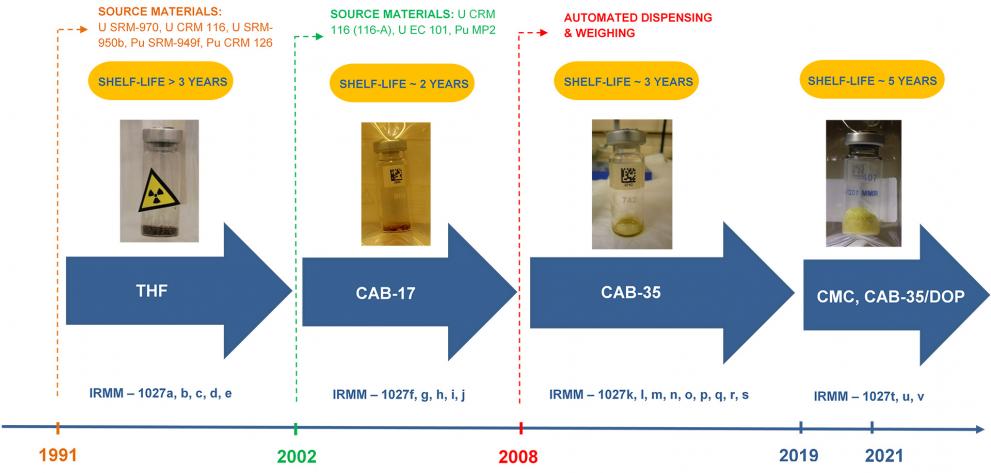
The EURATOM Treaty established a comprehensive and strict system of safeguards to ensure that civil nuclear materials are not diverted from their intended and peaceful use as declared by the Member States.
All non-nuclear weapon states that have signed the Treaty on the Non-Proliferation of Nuclear Weapons (NPT) must declare their fissile materials and comply with safeguards agreements. This involves the quantitative determination of the uranium and plutonium contents at different stages of the fuel cycle, and in particular in the dissolver solution of irradiated nuclear fuel at reprocessing plants.
Isotope dilution mass spectrometry (IDMS) is applied for the determination of uranium and plutonium contents in dissolved fuel when high accuracy is required. To achieve this, a well-characterised spike (e.g. tracer) reference material is needed. For this purpose, the Joint Research Centre (JRC) of the European Commission (EC) in Geel has developed and optimised the large-sized dried (LSD) spikes.
High-purity uranium and plutonium reference metals are used as starting materials to prepare the stock solution, which is then dispensed into individual units by an automated robot system, dried and embedded in an organic substance for shipment and long-term storage. These tailor-made reference materials, known as the IRMM-1027 series, have supported the safeguards community since 1991 (i.e. IRMM-1027a batch), meeting the JRC`s mandate as established in the EURATOM Treaty. They have been applied at the on-site laboratories of the European reprocessing plants of La Hague, France and until recently Sellafield, UK and in industry worldwide (Sellafield site, Japan Nuclear Fuel Limited).
Over the years, the IRMM-1027 LSD spikes have been optimised to meet customers’ needs and to improve quality. The main attention was given to the development of an organic substance that remains stable for the actinides embedded with it. In this context, various organic matrices have been used, from the initially applied tetrahydrofuran (THF) to cellulose acetate butyrate (CAB) and, finally, carboxymethyl cellulose (CMC) which was developed in cooperation with the JRC in Karlsruhe. The latter provides the LSD spikes with a stability of at least 5 years. This is a considerable achievement and an effective response to the customers` need for spikes with a prolonged shelf life.
The IRMM-1027 series are produced and certified in compliance with international standards (e.g. ISO 17034, ISO Guide 35). Special focus is given to the certification methodology, the assessment of homogeneity and stability and the combined uncertainties of the certified reference values. Together this makes the IRMM-1027 series a fit for safeguards purposes certified reference material. Laboratories and industry are using these LSD spikes to achieve their measurement results within the target uncertainties as required by the safeguards authorities (e.g. ITV 2010).
Further information
The publication 30 years of IRMM-1027 reference materials for fissile material accountancy and control: development, production and characterisation is available online at springer.com
The preparation and certification of IRMM-1027 LSD spikes is described in detail in the reports, available together with the certificate in the Certified Reference Materials catalogue of the JRC.
Related Content
JRC releases reference material IRMM-1027r for fissile material control
Details
- Publication date
- 8 September 2021
